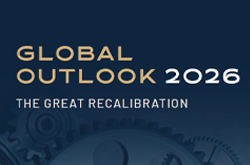The summer months were relatively calm for financial markets, with equity markets reaching new highs in September, despite historically unfavourable seasonality. Investors, however, face a dilemma: global growth is slowing but not collapsing, the Federal Reserve (Fed) is cutting rates, and valuations in many areas remain high or demanding. This leaves many hesitant to chase the rally.
EMPLOYMENT OR INFLATION RISKS?
At the Jackson Hole Symposium, Fed Chairman Jerome Powell made it clear where his focus lies: the labour market. While inflation risks remain “clearly visible”, they are viewed as largely one-off shocks. A softening United States (US) labour market is helping offset these risks. With immigration slowing, we now estimate US job creation to stabilise at approximately 70 thousand per month, half the previous pace.
The labour market is indeed the elephant in the room. A sharper slowdown could affect US consumer behaviour, yet forward-looking indicators remain resilient.
The Fed’s 0.25% rate cut in September was widely expected. We still anticipate three additional cuts over 2025 and 2026, we had one cut followed by two cuts in terms of sequence, the Fed has two and one. However, market expectations of three to four cuts in 2026 seem overly optimistic — or pessimistic for the economy.
VIEWS FROM ASIA
During a recent trip to the region, it was striking how sentiment had improved. Chinese equities received another boost this summer as investors sought to capitalise with Asia emerging as an alternative to US “Magnificent 7” stocks on the Artificial Intelligence (AI) rally. With an estimated 160 trillion yuans (20 trillion dollars) in domestic savings sitting idle in bank accounts — 60 trillion of which was accumulated since COVID-19 — there is significant potential for market-driven growth.
According to our Chief Strategist for Asia, Francis Tan, Chinese equity valuations remain attractive, with margins as a percentage of market capitalisation still below previous levels. Market reforms encouraging investments from domestic insurers and pension funds could further sustain gains.
Another key observation was the growing interest in diversifying away from the US dollar. For the first time in years, Asian clients are eyeing alternatives, particularly in Europe. While sectors like European banks and defence are drawing attention, challenges such as limited earnings growth and a lack of technol-ogy/AI plays persist. To be clear, it is not a run to sell the dollar, rather it is a run to hedge the dollar. Clients increasingly seek “pure” local returns by removing currency risk, even if it means absorbing hedging costs.
STAY INVESTED
We maintain a moderately pro-risk stance across asset classes. In equities, we have a constructive view. In fixed income, we continue to like high-quality credit in the US and Europe (see article Bonds: still offering attractive yields, page 10), while focusing on high yield bonds in Europe. We also reaffirm our positive stance on emerging market debt in local currencies, which remains underinvested globally.
I hope you enjoy this month’s publication, which highlights the rising role of stablecoins. Unlike volatile cryptocurrencies, they offer price stability, are increasingly used for payments in the US, and may become long-term buyers of Treasury bonds.
Monthly House View, 22.09.2025. - Excerpt of the Editorial
October 01, 2025




